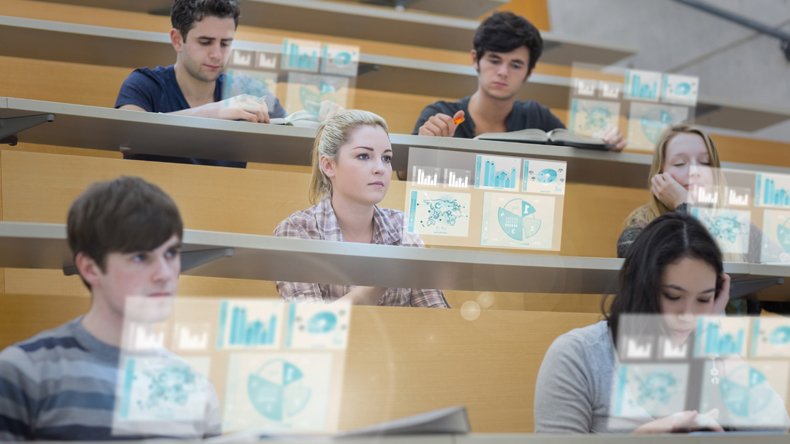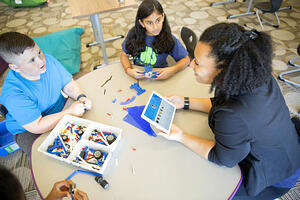
AI is here, we’re not talking of something in future. It's all around us and most of us including our kids have used it in our daily life. Whether we like it or not, AI is here and it is upto us to try and engage with it. In this post I'm trying to give readers a 50k foot view of AI and its impact on education, opportunity we have, the reality and the risks.
Table of Contents
- Introduction Artificial Intelligence(AI)
- Artificial Intelligence(AI) in Education
- Artificial Intelligence(AI) Opportunity
- Artificial Intelligence(AI) Reality
- Artificial Intelligence(AI) Risks
Universally when we think or talks about AI, robots is something that's often brought to mind, but we are using AI in our daily lives, without ever knowing or thinking about it.  Most us including our kid’s, have used AI in one or the other form , Siri or Alexa, computer games, photo apps, far recognition, stock market, autonomous cars, whether forecasting, google translation, stock market, passport control at airports, fake news news, banks, credit cards, loan application, and much more..
Most us including our kid’s, have used AI in one or the other form , Siri or Alexa, computer games, photo apps, far recognition, stock market, autonomous cars, whether forecasting, google translation, stock market, passport control at airports, fake news news, banks, credit cards, loan application, and much more..
AI is already here, technology in past decade has evolved dramatically due arrival of lots of big data and better computational approaches and together these have led to mushrooming of AI & related products & services. AI affects our lives in lots of different ways without us noticing it.
AI is also already in education, it’s helping us understand learning, enhance learning, developing learning experience based on individual students needs and skills.
In this post we are trying to look at artificial intelligence (AI) from a 50' thousand feet level and its impact on education, the opportunity we have, the reality and the risk associated with it.
1) Introducing Artificial Intelligence (AI)
AI is difficult to define
AI is constantly changing, “A lot of cutting edge AI has shifted into general applications, often without being called AI because once sorting becomes useful enough and common enough it is not often labelled AI anymore”. (Bostrom, 2016). It involves anthropologists, biologists, computers, scientists, learning scientists, linguists, neuroscientists, philosophers and physiologists, and each group brings their own perspective and terminology.
“ Computer systems that have been designed to interact with the world through capabilities ( for example, visual perception and speech recognition) and intelligent behaviors ( for example, assessing the available information and then taking the most sensible action to achieve a stated good) that we would thing as essential human.”( Luckin, Holmes, Forcier and Griffiths, 2016)
Perhaps, Ai is better thought of as‘Augmented Intelligence’ ?
Artificial Intelligence - Types
| AI Types | AI Techniques | AI Schools | AI as a service | AI Applications |
| NLP | Machine Learning | Evolutionaries | Microsoft Azure | Online Shopping |
| Speech recognition | Neural networks | Connectionists | IBM Watson | Auto- journalism |
| Image recognition | Evolutionary computation | Symbolists | Google Cloud | Online datings |
| Virtual agents | Back- propagation | Bayesians | TensorFlow | Healthcare |
| Autonomous vehicles | Supervised learning | Amazon AWS | Stocks and share dealing | |
| Smart robotics | Reinforcement learning | Passport control | ||
| Affect detection | Unsupervised learning | Alexa and Siri | ||
| General AI | Bayes nets | Legal & financial services | ||
| Hidden Markov Modeling | Robots | |||
| Computer games | ||||
| Self-driving cars | ||||
| Education |
a) Artificial Intelligence (AI) is based on Algorithms
The history of AI might be thought of as the history of increasingly sophisticated and increasingly efficient algorithms.
For example, the PageRank algorithm was the basis of Google search:
 Algorithms are nothing more than steps need to solve problems, and computer programs are really nothing more than complex algorithms. What makes AI algorithms distinct is the they are applied to area we might think of essentially human ( such as: visual perception, speech recognition, decision-making and learning).
Algorithms are nothing more than steps need to solve problems, and computer programs are really nothing more than complex algorithms. What makes AI algorithms distinct is the they are applied to area we might think of essentially human ( such as: visual perception, speech recognition, decision-making and learning).
b) Machine learning
Involves getting computers to act without being given explicit steps or rules.
c) Supervised learning
Involves training the algorithms with labelled data, so that it can label new data.
d) Unsupervised learning
Involves the algorithms finding patterns in unlabelled data, so that it can classify new data.
e) Reinforcement learning
Derives an outcome from some initial data, which is assessed as correct or incorrect, and rewarded or punished. The AI updates itself and tires again.
f) Evolutionary AI
Generates as many pieces of random code, each of which is evaluated. The code that is ‘most successful’ randomly mutates to produce many new pieces of code. Code that is unsuccessful is abandoned. The Process is repeated many times.
g) Neural networks
Are becoming increasingly important and are based on animal brains.  However, they usually involves only a few thousand ’neurons’, while human brain has around 100 billion neurons, they are not programmed to do something, instead they are trained to do it. - Google deepmind uses this AI. Hidden layers are key to the power of neural networks. The use of neural networks with many hidden layers is know as ‘deep learning’. It isn’t easy to interrogate neural network to find out ‘how’ it came up with its solution.
However, they usually involves only a few thousand ’neurons’, while human brain has around 100 billion neurons, they are not programmed to do something, instead they are trained to do it. - Google deepmind uses this AI. Hidden layers are key to the power of neural networks. The use of neural networks with many hidden layers is know as ‘deep learning’. It isn’t easy to interrogate neural network to find out ‘how’ it came up with its solution.
h) Narrow AI
Examples of AI mentioned above are domain-specific, tightly constrained and very limited. For example AI used to win at Go cannot play a game of chess, the AI used to predict the weather cannot predict movements in the stock market, and the AI used to drive a car cannot be used to fly an airplane.
i) General AI
Is artificial intelligence that is like human intelligence, can be used in any circumstances, it does not yet exist. And despite the rapid developments in AI and the concerns expressed by many leading scientists, it is not likely to exist for decades.
2) Artificial Intelligence (AI) in Education
An initial taxonomy
a) Intelligent Tutoring Systems - ( ITS)
The most common applications of AI in education is ITS. For Example: ALEKS, Bjyu, Realizelt, Alta (Knewton), Area9Learning, Assistments, iReady Dreambox, Century, Smartsparrow, Topper, Yixue and more. They provide step by step tutorials, individualized for each student, through topics in well-defined structured subjects such as mathematics or physics. Automatically determines an optimal step-by-step pathway through the learning material and activities, adjusts the level of difficulties, and provides, hints or guidance.
ITS Example - MATHIA
CARNEGIE LEARNING, is a mathematics learning ITS system, it aims to mirror a human tutor, taking a student step-by-step through the learning content.  It is being used by thousands of students across United States. In an independent study conducted by DoE & RAND corporation, students using MATHIA (Cognitive) Tutor achieved almost twice the progress ( on standard tests) compared to typical students.
It is being used by thousands of students across United States. In an independent study conducted by DoE & RAND corporation, students using MATHIA (Cognitive) Tutor achieved almost twice the progress ( on standard tests) compared to typical students.
b) Dialogue-Based Tutoring Systems (DBTS)
Rather than presenting an individualized sequence of instructional material or learning activities ( as in an ITS), DBTS engage students in conversations about the topic to be learned. Based on the assumption that real understanding of something involves being able to talk articulately about it. It uses Socratic tutoring principles ( probing with questions rather than providing instruction).
For example DBTS - WATSON TUTOR
Builds on an approach to tutorial dialogue developed over 20 years ( AutoTutor), driven by the IBM Watson “ Natural Language Understanding” API:

- Tutor poses a question/problem.
- Student attempts to answer.
- Tutor provides feedback.
- Collaborative interaction to improve the answer.
- Tutor checks if student understands.
c) Exploratory Learning Systems (ELEs)
Rather than following the ITS or DBTS a step-by-step sequence, students are encouraged to actively construct their own knowledge by exploring and manipulating elements of the learning environment. It includes AI-driven automatic guidance and feedback, addressing misconnects and proposing alternative, approaches, to support the student while they explore.
d) Automatic writing evaluation (AWE)
Uses natural language and semantic processing to provide automatic feedback on student writing submitted to the system. Can be formative (i.e., providing support enable a student to improve their writing before submitting it for assessment) or summative (i.e. automatic scoring).
For Example AWE -Open Essayist
- Developed by the OU and Oxford University.
- Provides automated formative feedback.
- Uses unsupervised learning and natural language processing to cluster key words, phrases and sentences from the student’s essay.
e) Learning Network Orchestrators (LNO)
Uses much simpler AI technologies to put students more in control of their own learning.Other than that, each Learning Network Orchestrator is different.
For Example: SMART LEARNING PARTNER (LNO)
- Students have a mobile app int which they enter the issues they want tutorial help on ( from differential calculus to the verb ‘avoid’ to…).
- This brings up a list of tutors, each of whom has been rated by other students (much like dating app).
- The student choses a tutor, receives up to 30 minutes of tuition (screen share and voice only). and rates the tutor.
- Data is shared with the schools (e.g. ‘many students are having difficulties with…”)
3)AI Opportunity
a) Collaborative Learning
- Collaborative learning is well know to lead to better learning outcomes, but effective collaboration between learners can be difficult to achieve.
- AIED offers various possibilities:
- Adaptive group formation: using knowledge about the participants to form a group best suited for a particular collaborative task.
- Expert facilitation: recognizing when students are having trouble understanding share concepts, and then providing targeted support.
- Intelligent virtual agents: contributing to the dialogues by acting as a coach, a virtual peer or teachable agent.
b) Learning Companions
- Could accompany and support individual learners throughout their studies, perhaps through their mobile phone ( a Siri for learning).
- Could help the learner to work out what to learn.
- Could suggest the order wand content of topics to be learned.
- Could offer individualized examples, feedback and guidance.
- Could be suitable for struggling and high-achieving learners alike.
c) AI Assistants
- Could enable ALs to monitor student performance while they learn.
- Could track students’ progress in detail.
- Could build and maintain learner models for each student, using interactions, voice recognition and eye tracking.
- Could recommend need learning opportunities for particular students.
- Could make our primitive ‘stop antes’ exams a thing of past.
4) Artificial Intelligence - Reality
a) Forum Monitoring
A working Group is investigating developing a prototype system that triages and aggregates online forum posts and detects indicators of student disaffection.Drawing on Georgia Tech’s ‘Jill Watson’, an AI bot that uses IBM Watson technology.Jill was one of teaching assistants ( the other were human) who monitored forum posts 300 students. Jill was responsible for responding to the most basic forum posts. Other posts were answered by the human teach assistants.
b)Student Support Tool
- Draws together data across the university, such as personal characteristics and performance in other modules.
- Predicts the grade for each student and each module.
- Can be used to identify students who are struggling with one particular area of study, so that student support team can provide targeted support.
c)Student Support Chatbots
- Uses a variety of technologies, and on various platforms ( e.g. web and Messenger)
- Able to address student questions and about exams.
- Assists students in language studies, ask students to compare cabot-human interaction and human - human interactions, using Amazon Alex Echo trailer of father using Alexa as he’s preparing dinner for his daughter.
5)The RISKs
a) Big Data
- What data is collected ( is the data private, consent given ?)
- What proxies are being used/misused ?
- How is the data analyzed ( there’s no such thing as a raw data)?
- What are the implications ?
b) Algorithms and computation
- How do we prevent algorithmic biases?
- How do we guard against mistakes?
- How do we protect against unintended consequences?
- How do we stay in control?
c) Risks in Education
- Self-fulfilling teacher expectations?
- Resource allocations ( including teacher expertise) ?
- Gender and ethnic biases?
- Behavior and discipline?
- Accuracy and validity of assessments?



